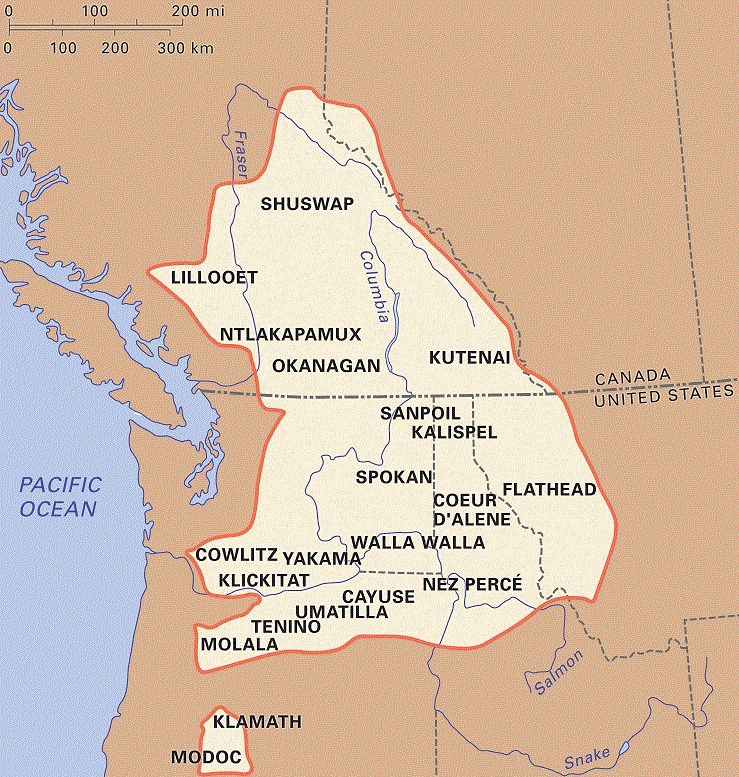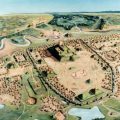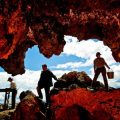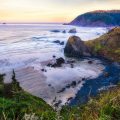The area between the Cascade Mountains and the Rocky Mountains in Washington, Oregon, Idaho, British Columbia, and Western Montana is known as the Plateau Culture area. From north to south it runs from the Fraser River in the north to the Blue Mountains in the south.

Much of the area is classified as semi-arid. Part of it is mountainous with pine forests in the higher elevations.
For the Indian people of the Plateau, camas (Camassia quamash) was an important food. Camas is a lily-like plant whose bulb can be fire-baked to make a sweet and nutritious staple. In some places in the Northwest, camas was so common that non-Indian travelers would mistake fields of the plant’s blue flowers for distant lakes. As a food source, camas is very high in protein: 5.4 ounces of protein per pound of roots. In comparison, steelhead trout (Salmo gairdneri) has 3.4 ounces of protein per pound.
Ethnographic Background:
There are a number of different stories about the origin of camas. According to one story, Moose, in order to feed his guests Coyote and Kingfisher, slapped his backside and out came Camas. He then put it in a kettle and gave it to his guests as food.
The proper time to gather camas is when the lower half of the flowers begin to fade. Indian people generally gathered camas in June, but this varied according to altitude and seasonal weather conditions. The camas was dug up by women using digging sticks made from elk antlers or fire-hardened sticks. A woman could dig up about a bushel of roots in a day from a site that was about half an acre in size. It was possible for a woman to gather enough camas in three or four days to feed her family for a year.
Among all of the food plants gathered by the Native peoples of the Plateau region, the camas bulbs required the most elaborate preparation. The sugar in the camas bulbs is indigestible until it is roasted and converted to fructose. By slow roasting the bulbs in an earth oven, camas becomes a useful food source.
The oven (a roasting pit dug into the ground) was preheated by building a fire in it and placing small rocks (about 5” in diameter) in with the wood. In addition to the small rocks, some pits had large flat stones on the bottom which were also heated by the fire. When the rocks were hot, they were covered with about 3 inches of wet vegetation such as slough grass, alder branches, willow, and/or skunk cabbage leaves. Then the camas bulbs were placed on top of the vegetation. Sometimes Douglas onions (Allium douglasii) were placed in with the camas. The camas was then covered with bark and earth and a fire was built on top of the oven. Cooking usually took between 12 and 70 hours, depending on the number of camas bulbs in the oven.
Although the men gathered the wood for the ovens, men were not allowed near the roasting pits for fear that the camas would not be roasted properly. In some of the tribes, the men were not supposed to even look in the direction of the camas ovens.
For the women, gathering and roasting the camas was a highly regarded skill. Writing about the Kalispel, Ruth Kirk and Richard Daugherty, in their book Archaeology in Washington, report: “Young women seeking guardian spirits hoped to gain ability to find roots, dig them, or roast and prepare them for storage. Skill in roasting roots was more valued than skill in digging them.”
The camas which was intended for storage was then dried for about a week. Dried camas can be preserved for many years. Some American explorers report eating camas that had been prepared 36 years earlier. The early Europeans in the area, such as Lewis and Clark, occasionally consumed camas after they were shown how to harvest it and prepare it. One Jesuit missionary fermented camas to make alcohol. Another Jesuit missionary observed that the consumption of camas by those unaccustomed to it is “followed by strong odors accompanied by loud sounds”.
In order to increase the camas yield, the camas areas, as well as other root gathering areas, were occasionally burned over.
Archaeology:
Since camas was a staple crop, the people would visit the gathering areas each year, often re-using the pit ovens at the camas camps. For archaeologists, the presence of the pit ovens provides good evidence that the people were harvesting camas.
The earliest evidence of the use of camas dates to about 6000 BCE, a time when the Old Cordilleran culture was beginning to replace the Windust culture. According to archaeologist James Keyser in his book Indian Rock Art of the Columbia Plateau: “Old Cordillaran people hunted deer, antelope, mountain sheep, and birds; took salmon and fresh-water mollusks from the rivers; and collected and processed berries and tuberous plants such as camas.”
Ethnographic accounts tell of rich camas fields in the Calispell Valley near Usk, Washington and the present-day Kalispel Reservation. In the 1980s, archaeologists began documenting the earth ovens in the area. The site dates to about 4800 BCE. The earth ovens range from two feet to 11 feet in diameter. With regard to depth, they range from about 5 inches to more than 2 feet. The camas season appears to have lasted for about two months. Ruth Kirk and Richard Daugherty report: “For the Kalispel people the pattern seems to have changed little in thousands of years. Recent ovens closely match the ancient ones.”
Archaeologists have, however, noted some changes in the use of camas. About 1500 BCE, camas became more intensely used in the Calispell Valley. At this same time, fishing also became more important.
A thousand years later, about 500 BCE, there is a major drought which damages the moist meadows. The use of camas decreased because of lack of availability. At this same time, there is an increase in the use of fire to increase food production at the higher elevations.
By 500 CE, the harvesting of camas in the Calispell Valley had once again intensified.




Leave a Reply